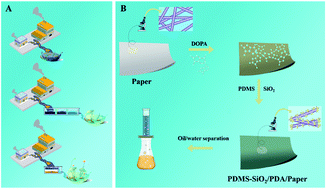Superhydrophobic paper with mussel-inspired polydimethylsiloxane–silica nanoparticle coatings for effective oil/water separation
Abstract
Although various filtration materials with (super)wetting properties have been fabricated for effective oil/water separation, eco-friendly and low-cost materials are still highly desired. This work details the facile preparation of efficient oil–water separation papers with superhydrophobic properties that successfully combine micro/nanoscale hierarchical particles and low surface energy components with porous substrates. The superhydrophilic papers were coated with a polydopamine layer and then immersed in the mixture of polydimethylsiloxane (PDMS) and hydrophobic-silica nanoparticles. The resultant paper can separate oil–water mixtures under gravity driving conditions, where heavy oil penetrates through the sample and water is collected on the surface. And the as-prepared sample had favorable separation efficiency (>99%). More importantly, the oil flux almost remained at the original value after 10 cycles, indicating excellent recyclability. In addition, the as-prepared paper exhibits good stability in acidic, alkaline and salty media.



 Please wait while we load your content...
Please wait while we load your content...